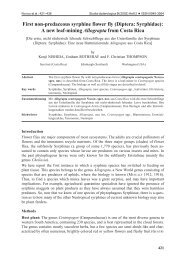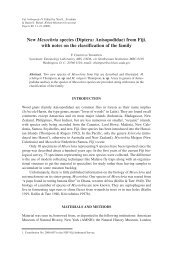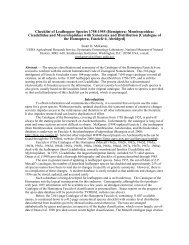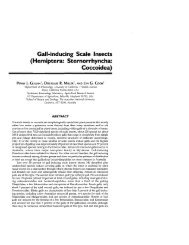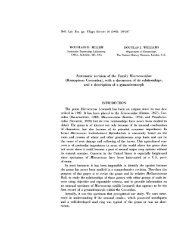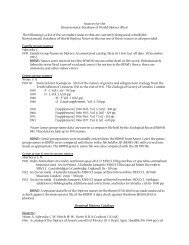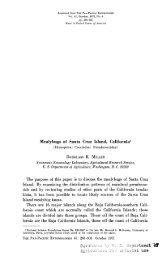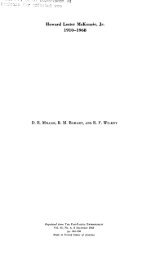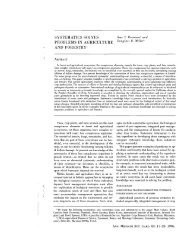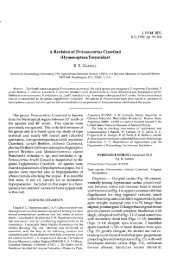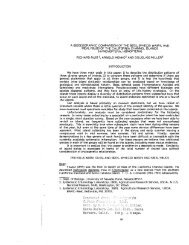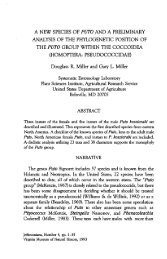Fruit Fly Expert Identification System and Systematic Information
Fruit Fly Expert Identification System and Systematic Information
Fruit Fly Expert Identification System and Systematic Information
You also want an ePaper? Increase the reach of your titles
YUMPU automatically turns print PDFs into web optimized ePapers that Google loves.
Norrbom Status of Knowledge 19<br />
Incertae Sedis Tephritidae<br />
Genera: PA, 3 (3); OR, 1 (1); total, 4. Species: NT, 5 (5); PA,<br />
23 (23); AF, 1 (1); OR, 1 (1); AU, 4 (4); total, 34.<br />
Chejuparia: PA, 1 (1); total, 1.<br />
Oxyphora: PA, 1 (1); total, 1.<br />
Pseudorellia: OR, 1 (1); total, 1.<br />
Stylia: PA, 1 (1); total, 1.<br />
Unplaced species: NT, 5 (5); PA, 20 (20); AF, 1 (1); AU, 4 (4); total,<br />
30.<br />
Recent changes from previous classifications<br />
Tephritid higher classification is currently in a state of<br />
rapid flux. Numerous changes have been proposed since publication<br />
of the most recent regional catalogs (Cogan & Munro<br />
1980, Foote 1965[1502], 1967[1508], 1984, Hardy 1977,<br />
Hardy & Foote 1989), which themselves differ in classification.<br />
More emphasis on comprehensive, worldwide studies rather<br />
than regional faunas, more thorough study of genitalic characters,<br />
<strong>and</strong> introduction of phylogenetic analysis have contributed<br />
to these advances <strong>and</strong> doubtless will continue to improve our<br />
knowledge of fruit fly relationships. Here we attempt to list the<br />
most significant changes in higher classification since publication<br />
of the regional catalogs.<br />
We have generally avoided the recognition of monogeneric<br />
higher taxa in the above classification. Unless their sister<br />
group relationships are understood, such taxa add little predictive<br />
value to a classification. Genera whose relationships are<br />
uncertain are instead listed under “Incertae sedis” (unplaced).<br />
For the Phytalmyiinae, we generally follow the classification<br />
of Korneyev (1994[2744]), but we prefer to include within<br />
it several other taxa (Acanthonevrini, Blepharoneurini, Epacrocerini,<br />
<strong>and</strong> Phascini) that he ranked as separate subfamilies.<br />
These taxa have often been included within the Trypetinae.<br />
Hardy (1980[1949], 1986[1962]) <strong>and</strong> Hancock (1986[1890])<br />
also included important discussions of the classification of the<br />
Acanthonevrini, <strong>and</strong> Hardy (1983[1957]) <strong>and</strong> McAlpine &<br />
Schneider (1978) discussed the Phytalmiini. Following Korneyev<br />
(1994[2744]), Terastiomyiini is considered a synonym<br />
of Phytalmiini. According to Korneyev (pers. comm.), Homoiothemara<br />
also belongs in the Phascini.<br />
Within the subfamily Trypetinae, Euphrantini are no<br />
longer recognized as distinct from Adramini (White & Elson-<br />
Harris 1992, Korneyev 1994[2744]). Korneyev (1994[2744])<br />
<strong>and</strong> Hardy (1983[1958], 1986[1961]) discussed the limits <strong>and</strong><br />
included genera of this group. Genera that were previously<br />
included only on the basis of having reduced chaetotaxy <strong>and</strong> a<br />
strongly sclerotized bridge behind the metathoracic coxae are<br />
here mostly included in the Phytalmiini. The tribe Carpomyini<br />
was recently proposed as a subtribe of Trypetini (Norrbom<br />
1989[3653], 1994[3663]), but we follow Han & McPheron<br />
(1994) in ranking it as a tribe because its relationship with the<br />
Trypetini is uncertain. Korneyev (1996 [2747]) recently added<br />
two small subtribes, the Notommatina <strong>and</strong> Paraterelliina.<br />
The Dacina, usually previously ranked as a subfamily, or<br />
even as a separate family (Munro 1984), because of their<br />
distinctive appearance <strong>and</strong> the large size of the group, is now<br />
included as a subtribe of Trypetinae. It is included in the tribe<br />
Dacini with the Ceratitidina <strong>and</strong> Gastrozonina (Hancock<br />
1986[1890], Foote et al. 1993). Drew (1989[232], 1989[1231])<br />
<strong>and</strong> Drew & Hancock (1994[1239]) discussed the generic <strong>and</strong><br />
subgeneric classification (see also Hardy 1955[1927] <strong>and</strong><br />
Drew 1972[1216], 1979). The large genus Dacus has been<br />
divided, <strong>and</strong> many of its subgenera <strong>and</strong> species are now placed<br />
in Bactrocera. Munro (1984) proposed numerous subfamilies<br />
<strong>and</strong> tribes within the Dacina (as Dacidae), but his classification<br />
has not been accepted (Hancock 1986[1890], Drew<br />
1989[232]). We follow the synonymy suggested by White &<br />
Elson-Harris (1992) for the genus group names Munro proposed.<br />
The classification of the Ceratitidina was briefly discussed<br />
by Hancock (1984, 1987). The limits of this group <strong>and</strong> the<br />
Gastrozonina are poorly resolved. Hancock (1985[1889]) <strong>and</strong><br />
Hancock & Drew (1994[1901]) included several genera without<br />
a strongly apically pointed antennal first flagellomere that<br />
traditionally have been classified under Gastrozonina (Hardy<br />
1973, 1974[1943], 1988[1964]). The Gastrozonina have been<br />
considered as a subordinate taxon to Acanthonevrini (Hardy<br />
1988[1964]), but Hancock (1985 [1889]) considered them<br />
related to the Ceratitidina. Hancock (1985[1889], 1991[1895]),<br />
Hancock & Drew (1994[1901]), <strong>and</strong> Hardy (1988[1964]) discussed<br />
the definition of the group <strong>and</strong> the included genera. The<br />
correct stem for the family group name based on Ceratitis is<br />
Ceratitid-, rather than Ceratit-, <strong>and</strong> a name based on the latter<br />
stem is preoccupied by the ammonite name Ceratitidae Mojsisovics<br />
(D.L. Hancock, C.W. Sabrosky, pers. comm.).<br />
Hancock (1986[1890], 1991[1895]), Norrbom (1985,<br />
1994[3662]), <strong>and</strong> Norrbom & Foote (1989) discussed the classification<br />
of the Ortalotrypetini, Rivelliomimini, <strong>and</strong> Toxotrypanini,<br />
recognized here as tribes. Ischyropteron also belongs in<br />
the Ortalotrypetini (Norrbom, pers. obs.), <strong>and</strong> Hexachaeta is<br />
here included in the Toxotrypanini based on molecular data<br />
(Han & McPheron, 1997). A number of Neotropical genera<br />
previously included in the Trypetinae (R.H. Foote 1967[1508])<br />
have been transferred to the Tephritinae (Norrbom 1988, Foote<br />
et al. 1993).<br />
The Trypetini were recently redefined by Han (1992). His<br />
classification is used here, except that the subtribes Acidoxanthina<br />
<strong>and</strong> Nitrariomyiina recently proposed by Korneyev<br />
(1996 [2747]) <strong>and</strong> several additional genera are also included.<br />
Hancock (1986[1890]) suggested that the Acidoxanthina belong<br />
in the Ceratitidina.<br />
The Zaceratini (Hancock 1986[1890]) <strong>and</strong> Plioreoceptini<br />
(Korneyev 1987[2726]) were each proposed as monogeneric<br />
tribes. Their synonymy was noted by White & Elson-Harris<br />
(1992).<br />
The subfamily Tephritinae includes some taxa previously<br />
given subfamily rank: the Myopitini, Tephrellini (as Aciurinae),<br />
Terelliini, Oedaspidina, <strong>and</strong> Schistopterini (e.g., Hering<br />
1947, Cogan & Munro 1980). The Myopitini <strong>and</strong> Tephrellini<br />
have sometimes been included in the Trypetinae (e.g., Hardy<br />
1977). The limits of many of the tribes of the Tephritinae are<br />
vague (Hancock 1986[1891], Foote et al. 1993), <strong>and</strong> Hancock<br />
(1990) included all of them except the Myopitini, Terelliini,<br />
<strong>and</strong> some Tephrellini within the Tephritini.<br />
Hancock (1990) indicated that Tephrellini is the valid<br />
name for the group previously called Aciurini. In the classification<br />
followed here (Cogan & Munro 1980, Freidberg, pers.<br />
obs.), it also includes the Platensinina, sometimes recognized



